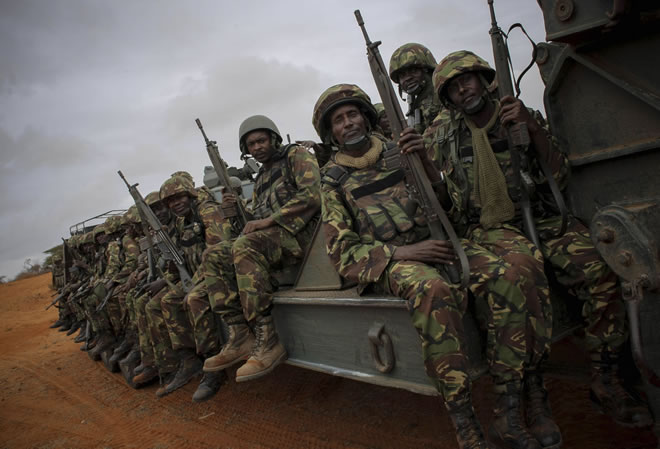

By Nyambega Gisesa
Sunday, August 10, 2014
advertisements
NAIROBI, KENYA: The Kenya Defence Forces ( KDF) is preparing for a major assault since the heroic capture of Somalia’s port city of Kismayu as they go for Jilip, another al-Shabaab stronghold.In newly-changed operational sectors that The Standard on Sunday can reveal today, KDF has been tasked with one of the toughest regions, still a bedrock of the militants.
“There are now six sectors in our area of operation, with KDF responsible for Sector 2 that comprises Lower and Middle Jubba regions,” Colonel Ali Houmed, an officer from the Djibouti Army, who is the Amisom Spokesman, told The Sunday Standard in an exclusive interview.
Amisom has added two more sectors to make them six, as a more effective way of dealing with the militants.
Although the capture of Kismayu was supposed to fatally destroy al-Shabaab, it was never the case since the militants moved to the vast South-Central Somalia where they have been regrouping in towns such as Barawe, Jilip and Diinsoor.
Col Houmed said al-Shabaab managed to regroup because the ongoing operation is not a conventional warfare. “We are now looking at asymmetric warfare, where there is no centre of gravity for al-Shabaab. We have radically weakened their military capabilities and there are few places they can now call a stronghold,” he said.
HUNTED DOWN
Barawe is the town where US Special Forces were involved in an unsuccessful operation last year to hunt down one of the masterminds of the Westgate terror attack.
Ugandan Forces are expected to lead the onslaught on Barawe while Kenyans will head to Jilip. “From a sectoral perspective, priorities for KDF include liberating the towns of Jilib and Jamaame and they have already scored successes in this objective,” Col Houmed said.
Al-Shabaab militants have been operating freely in Jilip, where they have ordered telecommunications companies to cut Internet services, abducted children who are trained as militants and banned the use of smartphones and satellite television for fear of being spied on.
Jilib houses the largest telecommunications lines connecting Mogadishu to Lower and Middle Jubba regions.
In preparation of the ground attack in what in military parlance in known as “softening the target”, the Kenya Air Force has been carrying out air strikes directed to Jilib and other surrounding areas.
The six sectors will be manned by different Amisom contributing troops jointly with the Somali National Army Forces.
Sector 2, whose vegetation is primarily semi-arid savannah with thorn bushes, comprises the districts of Kismayu, Jilib, Jamaame, Hagar, Afmadow, Badaadhe, Bua’ale and Sakow.
Sector 1 comprises Benadir and Lower Shabelle regions of the country and is commanded by Uganda People’s Defence Forces and Sector 3 comprises Bay, Bakool and Gedo under the command of the Ethiopian National Defence Forces. Sector 4 comprises Hiiraan and Galgaduud under Djibouti Defence Forces while Sector 5 is under Burundi National Defence Forces and covers Middle Shabelle region.
The last sector is 6 better known as Sector Kismayu, which has been a subject of controversy since the port city was captured by Kenyan troops in 2012.
KDF is no longer commanding Sector Kismayu that covers the town of Kismayu and its environs. The operation area is now under Sierra Leone Armed Forces.
However, a company of Kenyan and Burundian forces is still based at Sector Kismayu, guarding key installations like the Kismayu International Airport and high target individuals like the President of Jubba Administration Sheikh Ahmed Madobe.
FRESH BOOTS
Sources in the Kenyan military said most of the 3,662 troops in Somalia will be exchanged with fresh boots for the onslaught.
The Kenyans are fourth largest among Amisom troops, with a total strength of 22,126. This includes 540 police officers from Uganda, Kenya, Sierra Leone, Nigeria and Ghana. The remaining 21,586 are military men and women. Uganda has 6,220 troops, Burundi has 5,338, Ethiopia 4,395, and Djibouti 994, while Sierra Leone has 850.
Most soldiers heading back to Somalia are drawn from the battle groups that were involved at the start of Operation Linda Nchi in 2011.
“We have been prepared to go back to war and we are ready,” one soldier said. There is still no codename for the new mission.
After Kismayu, Amisom launched an offensive codenamed Operation Eagle that resulted in the liberation of 10 strategic towns from the brutal grip of al-Shabaab. The captured towns include Qoryooley, Maxaas, Bulo Burte, Ceel Buur, Qurullow, Waajid, Xuddur and Ted.
Operation Eagle was the last offensive for Amisom troops. “Our operations are ongoing and a new offensive is underway,” Col Houmed said, explaining that the new offensive aims at routing al-Shabaab out of Somalia and depleting their ideological and military support base.
Col Houmed explained that their progress is hampered by the lack of aircraft for transport and to carry out air strikes. “While Amisom is mandated to do air assets, it is important to point out that the mission does not have any aircraft and therefore, we do not carry air strikes,” he said.
“However, contingents such as the Kenya Defence Force have carried out limited airstrikes on key targets. As a mission, this is a shot in the arm and very important for us because we have vowed to use all resources at our disposal,” he added.
Col Houmed said Amisom’s immediate biggest call for support to the international community is focused on acquiring air assets (mainly transport and combat helicopters) which would enable them move troops faster, conduct better surveillance, transport injured soldiers and carry out airstrikes as well as access remote areas.